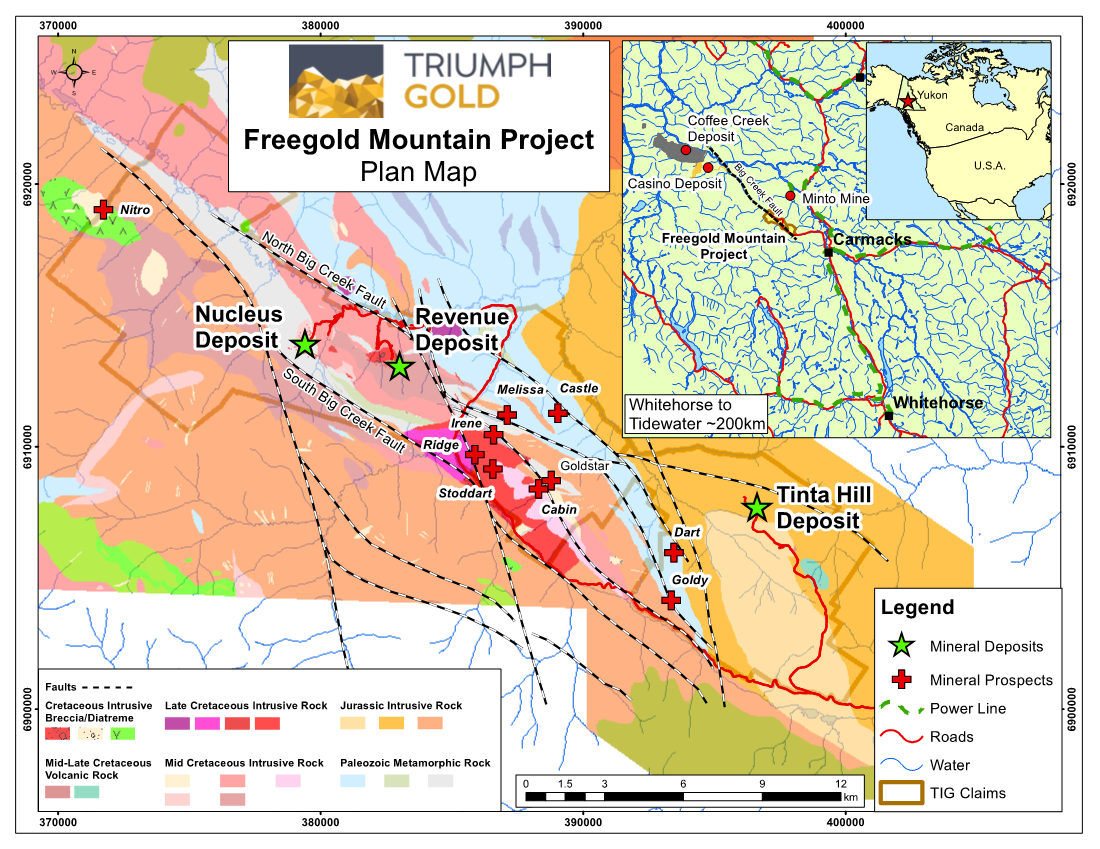Apr 15 2021
Triumph Gold Corp., a Canadian-based, growth-oriented exploration and development company, has provided an update on exploration activities for its flagship Freegold Mountain Project situated in the productive Dawson Range Copper-Gold District of mining-friendly Yukon.
 Plan map of the Freegold Mountain Project, Yukon. Image Credit: Triumph Gold Corp.
Plan map of the Freegold Mountain Project, Yukon. Image Credit: Triumph Gold Corp.
The Freegold Mountain Project spans a 200-km2 road-accessible part of the Big Creek Fault—a structural system that is directly associated with skarn mineralization and gold-rich porphyry copper, epithermal, and associated polymetallic vein.
The district-scale Freegold Mountain Project is host to rich copper-gold prospects and also three current NI 43-101 compliant Mineral Deposits, as shown in the above figure.
The technical team of Triumph Gold is in the last stages of developing an exploration program for the Freegold Mountain Project set to begin in late Spring.
The 2021 program will target resource expansion and will also test new targets at the Nucleus, Revenue and the Melissa Zone, and will be built on important developments made in the H1 of 2021 via the following successful projects:
- Understanding the recently-produced IP/MT and Drillhole-Constrained Magnetic 3D Inversion geophysical models to detect formerly unobserved structural controls on mineralization in the Revenue-Nucleus region.
- Conclusion of a 3D redox model to detect and target the potential oxide gold in the Revenue-Nucleus region.
- Receipt of required orientation data for major elements emphasized by Minerva Intelligence innovative Artificial Intelligence technologies to detect unbiased mineralization vectors in the Revenue-Nucleus region.
- Creation of detailed alteration models through assessment of more than 40,000 m of drill-hole spectral data (PIMA and TerraSpec) to detect strong alteration vectors across the Freegold Mountain Project region.
- Digitization and confirmation of geophysical, geochemical and geological data in the newly-acquired Micromine 3D modeling software, leading to validation and creation of new exploration targets across the Freegold Mountain Project area.
Triumph Gold is also happy to announce that Tutchone Environmental Consulting—a business owned by Little Salmon Carmacks First Nation citizens—has been engaged to begin surface water baseline analyses across the Freegold Mountain Project region.
Geochemical and geophysical surveys are some of the additional work being considered for 2021. These surveys cover many targets on the Freegold Mountain Project, such as the Tinta Hill, Stoddart/Cabin Porphyry and Irene-Goldstar Corridor.
Project Geology
The Freegold Mountain Project is located inside a northwest-trending belt of Paleozoic-aged metasedimentary rocks and fewer metavolcanic rocks intervened by Jurassic-aged plutons.
Running through the length of the Freegold Mountain Project is a long-lived regional fault system that is related to various mid-Cretaceous intrusions and late-Cretaceous intrusions; the latter is directly linked to gold-rich porphyry copper style mineralization and related skarn mineralization and epithermal vein.
The Freegold Mountain Project has a minimum of three types of deposits, robustly controlled by structure and stratigraphy:
- Low-sulfidation gold-silver polymetallic and epithermal vein mineralization is usually detected close to late-Cretaceous quartz-feldspar porphyry dikes.
- Gold-rich copper porphyry mineralization situated along structures inside mid-Cretaceous monzodiorite, granodiorite and quartz monzonite intrusions.
- Copper-gold skarn mineralization is close to intrusions and along structures inside the metasedimentary units.
Project History
The Freegold Mountain Project spans a vast region inside the Dawson Range in which copper-gold prospects have been occasionally investigated since the 1930s when magnetite float carrying visible gold on the ridge north of Seymour Creek was identified by Fred “Fritz” Guder, and polymetallic veins at Tinta Hill was identified and trenched by George McDade.
Early in the 1950s, additional prospecting revealed a large chalcopyrite vein in bedrock at the Revenue Creek. Subsequent gold and copper showings have been detected across the northwest-trending belt of rocks hosting this finding.
The discovery of the Revenue Creek resulted in the Revenue gold-copper-molybdenum deposit and following discovery of the neighboring Nucleus gold-silver deposit.
Many other copper-gold prospects are covered across the district-scale Freegold Mountain Project, including but not limited to porphyry targets at Castle, Stoddart, Nitro and Cabin; the many skarn targets of the Mount Freegold Project; and epithermal targets in the Irene-Goldstar Corridor and also Dart, Goldy and Ridge.
Resource Estimates
Three NI 43-101-compliant mineral resource estimates, such as the Revenue, Nucleus, and Tinta Hill Deposits, are hosted by the Freegold Mountain Project.
These three deposits, in turn, host open-pit constrained mineral resources, along with two of the Tinta Hill and Revenue deposits, including high grade, deeper mineral resources that are believed to be amenable to underground extraction techniques.
The deposits contain combined Inferred Mineral Resources from Tinta Hill, Nucleus, and Revenue of 1.1 million oz containing the gold equivalent and combined Indicated Mineral Resources from Nucleus and Revenue of 1 million oz containing the gold equivalent.
COVID-19 Response
Triumph Gold is devoted to the safety and health of its staff and contractors. With suggestions from the Yukon Chamber of Mines and the Yukon Government, Triumph Gold has designed and applied infection prevention and control measures at the Freegold Mountain Project to reduce the risk of possible coronavirus disease (COVID-19) spread in the camp and associated work locations.
As of April 13th, 2021, Yukon had 75 confirmed cases of COVID-19, of which 73 have been resolved by complete recovery, and 42,354 vaccine doses have been administered inside the territory.